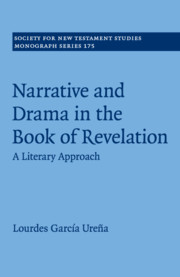Book contents
- Narrative and Drama in the Book of Revelation
- Society for New Testament Studies:
- Narrative and Drama in the Book of Revelation
- Copyright page
- Dedication
- Contents
- Tables
- Preface
- Abbreviations
- Introduction
- 1 The Literary Forms of the Book of Revelation
- 2 John, Eyewitness and Herald of the Visions
- 3 John, Auditory Witness and Herald of the Word
- Epilogue
- Bibliography
- Index of Ancient Sources
- Subject Index
3 - John, Auditory Witness and Herald of the Word
Published online by Cambridge University Press: 15 August 2019
- Narrative and Drama in the Book of Revelation
- Society for New Testament Studies:
- Narrative and Drama in the Book of Revelation
- Copyright page
- Dedication
- Contents
- Tables
- Preface
- Abbreviations
- Introduction
- 1 The Literary Forms of the Book of Revelation
- 2 John, Eyewitness and Herald of the Visions
- 3 John, Auditory Witness and Herald of the Word
- Epilogue
- Bibliography
- Index of Ancient Sources
- Subject Index
Summary
If description facilitates the effect of ante oculos ponere, one can also state (echoing Cicero) that direct speech confers upon John the power ad aures ponere, allowing him simultaneously to appear as a mere spectator and aural witness to what he has heard. This explains the recurrent use of the lexeme ????sa throughout the entire account. As we know, direct speech facilitates the momentary concealment of the narrator. John deftly uses this device to shift the protagonist role to the voices that he hears. To recreate the dramatic action, the author of the book of Revelation borrows various techniques from tragedy: the chorus; a frequent recourse to deixis; the use of dialogue to indicate movement; and messenger speeches. As though these theatrical devices were not sufficient to express what the narrator heard, the author also makes use of the dramatized epistolary form. In addition, we must remember that John also witnessed an aural environment replete with celestial chanting, the sound of trumpets, etc. Through language, the audience is immersed in the revelation’s aural context. Finally, John is aware that his text will be read aloud; this explains the use of the oral style.
Keywords
- Type
- Chapter
- Information
- Narrative and Drama in the Book of RevelationA Literary Approach, pp. 126 - 187Publisher: Cambridge University PressPrint publication year: 2019

